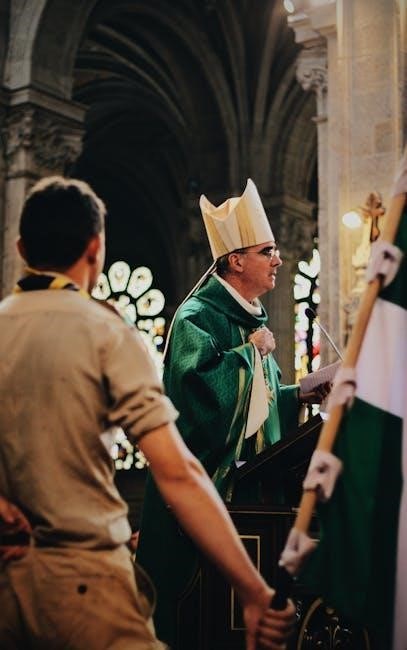priest pdf
Definition of Priest
A priest is a religious leader authorized to perform sacred rituals. They act as mediators between humans and deities, administering religious rites. In Christianity, they rank below bishops and above deacons, serving congregations of believers.
Religious Leader
A priest serves as a religious leader within a community. They guide and shepherd their congregations, offering spiritual direction and support. The priest is often seen as a figure of authority on religious matters, providing counsel and teaching sacred information. Their role involves upholding religious traditions, preserving the faith, and serving as a moral compass for their followers, leading worship and fostering a sense of community.
Mediator Between Humans and God
The priest functions as a crucial intermediary, bridging the gap between humanity and the divine. Their role involves offering sacrifices, prayers, and performing rituals believed to propitiate deities. Priests are authorized to perform sacred rites that facilitate communication and connection with the spiritual realm. They act as representatives of the people, conveying their needs and desires to a higher power, seeking divine favor and guidance on behalf of their community.
Authority to Administer Religious Rites
Priests possess the recognized authority to perform specific religious ceremonies and rituals within their faith tradition. This authorization typically stems from ordination or consecration, granting them the power to administer sacraments, blessings, and other sacred acts. Their role includes officiating at weddings, funerals, baptisms, and other key life events; The priest’s administration of these rites is believed to invoke divine grace and blessings upon individuals and the community, reinforcing spiritual bonds and upholding religious traditions.
Priesthood in Christianity
In Christianity, the priesthood is a sacred office. Priests serve various roles within Christian churches. They act as celebrants of the Eucharist and provide spiritual guidance. Ministers often substitute for priests in Protestant churches.
Role in Christian Churches
Within Christian churches, a priest’s role encompasses various responsibilities. They are authorized to perform sacred rites, acting as a mediatory agent. Priests administer sacraments, such as baptism. They may also lead congregations in prayer and offer spiritual guidance. They are often seen as representatives of Christ, serving their communities. A priest’s role varies depending on the specific denomination and its traditions, but essentially, they are leaders within their faith communities. They provide support.
Intermediate Between Bishop and Deacon
In the hierarchical structure of Christian churches, particularly within the Anglican, Eastern Orthodox, and Roman Catholic traditions, the priest holds an intermediate position. Ranking below the bishop, who typically oversees a diocese, and above the deacon, who often assists in liturgical and charitable duties, the priest serves as a key link. They lead local congregations, administer sacraments, and provide pastoral care. This intermediary role is crucial for maintaining the structure of the church and serving the spiritual needs of the community.
Celebrant of the Eucharist
A central role of a priest, particularly within the Catholic Church, is as the celebrant of the Eucharist. This sacred ritual, also known as Holy Communion, commemorates the Last Supper of Jesus Christ. The priest presides over the ceremony, consecrating the bread and wine, which are believed to become the body and blood of Christ. As celebrant, the priest acts in persona Christi, representing Christ himself during this most important act of worship. This role highlights the priest’s vital function in connecting the faithful with the divine through the sacraments.
Catholic Priest
A Catholic priest is a man called by God to serve Christ and the Church. Through Holy Orders, he dedicates his life to building up the Church and ministering to the faithful.
Called by God to Serve
The vocation to the Catholic priesthood is rooted in a divine calling. Men who feel drawn to this life often experience a profound sense that God is inviting them to serve Him and His Church in a unique way. This calling is discerned through prayer, reflection, and guidance from spiritual mentors. Ultimately, it’s a response to God’s invitation to dedicate oneself to the service of others and the proclamation of the Gospel, embracing a life of celibacy, obedience, and poverty.
Sacrament of Holy Orders
The priesthood in the Catholic Church is conferred through the Sacrament of Holy Orders. This sacrament, administered by a bishop, imprints an indelible spiritual character on the soul of the one ordained. Through Holy Orders, a man is configured to Christ, the High Priest, and receives the grace to fulfill the sacred duties of his office. He is empowered to celebrate the Eucharist, forgive sins, and preach the Gospel with authority, acting in persona Christi (in the person of Christ).
Building Up the Church
Catholic priests play a vital role in building up the Church. They serve the faithful by administering the sacraments, offering spiritual guidance, and teaching the truths of the faith. Through their ministry, they foster community, promote charity, and work for the salvation of souls. Priests are called to be shepherds, leading their flock to Christ. They are expected to dedicate themselves to the service of God and His people, striving for holiness in their own lives and inspiring others to do the same. Their work strengthens the Body of Christ.
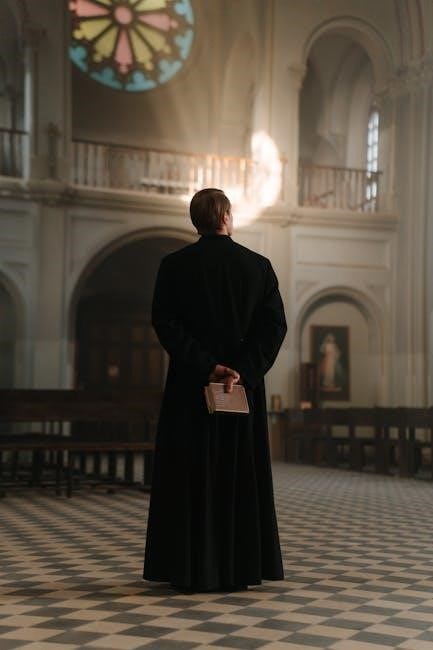
Priest in Other Religions
Priests exist in many religions, representing a higher power. They teach sacred information and perform duties to preserve faith. They often serve as intermediaries, connecting people to the divine through rituals and guidance.
Representative of a Higher Power
Across diverse faiths, priests often embody the role of a representative of a higher power. They are seen as conduits, connecting the earthly realm with the divine. Through their actions, rituals, and teachings, they exemplify the principles and values of their respective religions. This representation fosters a sense of connection and guidance for believers, offering a tangible link to the spiritual realm and providing a framework for understanding and interacting with the divine.
Teaching Sacred Information
A crucial function of priests involves teaching sacred information to their communities. They are entrusted with interpreting and disseminating religious texts, doctrines, and traditions. Through sermons, educational programs, and personal guidance, priests impart knowledge and understanding, shaping the beliefs and values of their followers. This role is essential for preserving religious heritage and ensuring the continuity of faith across generations. Furthermore, this guidance provides moral frameworks for individuals.
Preserving Faith
Priests play a vital role in preserving faith within their respective communities. They uphold religious traditions, practices, and values, ensuring their continuity across generations. Through consistent teaching, ritual performance, and community engagement, priests reinforce the foundations of belief. They guide individuals in navigating life’s challenges while maintaining their spiritual connection, offering support and encouragement to remain steadfast in their faith amidst adversity. This is an essential aspect of their ministry.
Etymology of “Priest”
The word “priest” originates from the Greek “presbyteros,” meaning “elder.” It relates to the Latin “sacerdos,” denoting a minister of divine worship, especially sacrifice. The term signifies a leader within a religious community.
Origin from “Presbyteros” (Elder)
The etymological roots of the word “priest” trace back to the Greek term “presbyteros,” which translates to “elder.” This signifies the early understanding of priests as respected seniors within their religious communities. These individuals held positions of leadership and guidance, reflecting the wisdom and experience associated with age. The “presbyteros” were entrusted with maintaining traditions, offering counsel, and overseeing the spiritual well-being of the community, embodying the role of a wise and knowledgeable elder.
Relationship to “Sacerdos”
While “priest” derives from “presbyteros,” it has also taken on the meaning of “sacerdos” in some languages. “Sacerdos,” a Latin term, refers to one who offers sacrifice, highlighting the priest’s role in divine worship. The priest acts as a minister, facilitating the connection between the people and the divine. The term signifies a focus on the performance of sacred duties and ceremonies, especially in the context of sacrifice and propitiation. The priest is a religious leader authorized to perform the sacred rituals of a religion
Minister of Divine Worship
The priest serves as a minister of divine worship, especially in acts of sacrifice. This role emphasizes the priest’s responsibility in leading and facilitating religious ceremonies. They act as a bridge between the community and the divine, offering prayers and performing rituals. This role also includes guiding the faithful in their spiritual practices and fostering a deeper connection with the sacred. The priest is a religious leader authorized to perform the sacred rituals of a religion, especially as a mediatory agent between humans and one or more deities
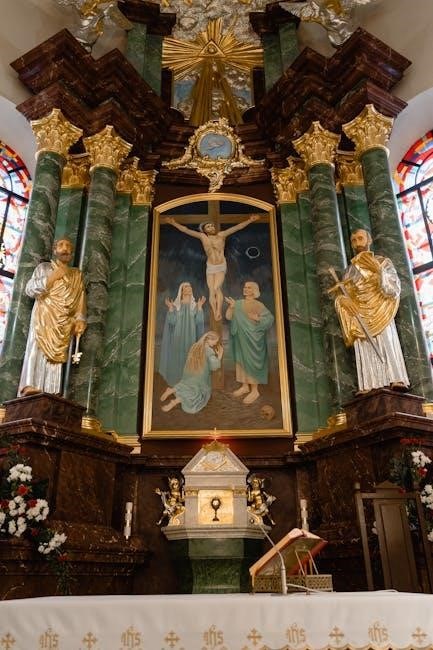
Ordination of Priests
Becoming a priest involves a specific process, including training, education, and a formal ceremony of ordination. This process prepares individuals to perform religious duties and serve as spiritual leaders within their communities.
Process of Becoming a Priest
The journey to priesthood typically begins with a calling or a sense of vocation. Aspiring priests undergo rigorous training, often including theological studies and spiritual formation. This involves academic learning, pastoral experience, and personal development. Candidates may spend time in seminaries or religious institutions, learning about scripture, theology, and church traditions. The process culminates in ordination, where the candidate is consecrated and authorized to perform priestly duties, marking a significant commitment to religious service.
Training and Education
Becoming a priest necessitates extensive training and education. This typically involves theological studies at a seminary or religious institution. Candidates delve into scripture, theology, church history, and pastoral care. They also receive practical training in areas like preaching, counseling, and administering sacraments. Education emphasizes both intellectual and spiritual growth, preparing individuals for the responsibilities of priesthood. The curriculum cultivates a deep understanding of religious teachings and the skills to effectively serve their community and lead worship.
Ceremony of Ordination
The culmination of priestly training is the ceremony of ordination. This is a sacred ritual where candidates are formally consecrated as priests. Typically presided over by a bishop, the ceremony involves specific prayers, blessings, and the laying on of hands. During this act, the bishop invokes the Holy Spirit, bestowing the authority and grace necessary for priestly ministry. The newly ordained priests then vow to uphold their duties, serve the church, and lead their congregations in faith. This marks their official entry into the priesthood.
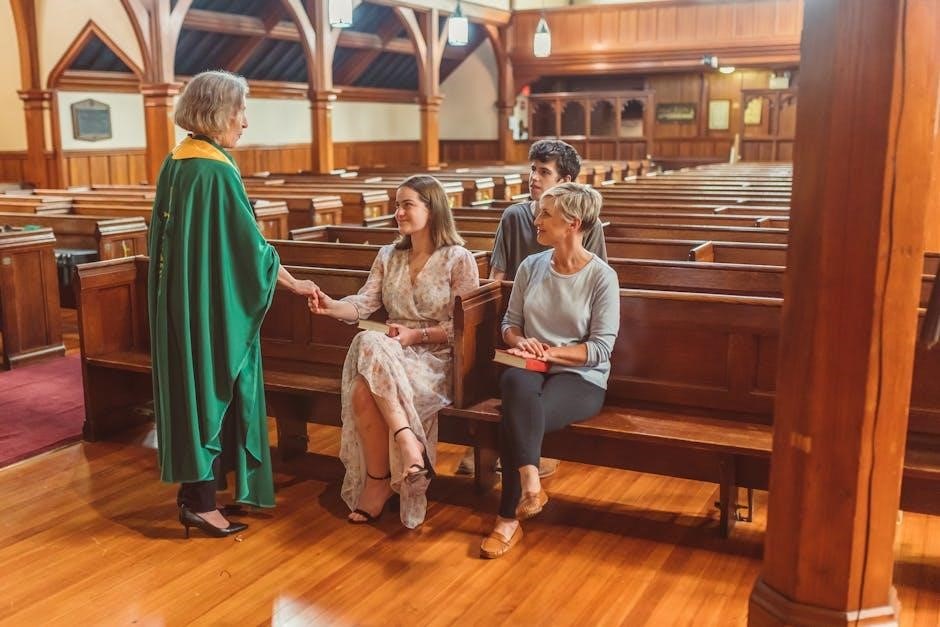
Ban on Women Priests
The Catholic Church maintains a policy against ordaining women as priests. This stance is rooted in theological interpretations and tradition. However, this ban faces ongoing debate within and outside the Church, questioning its historical context.
Catholic Church Policy
The Catholic Church’s official policy prohibits the ordination of women to the priesthood. This position is grounded in the belief that Christ chose only men as apostles. The Church believes it lacks the authority to alter this fundamental practice. This stance is based on sacred scripture and longstanding tradition. The Magisterium, the Church’s teaching authority, consistently upholds this doctrine. This policy remains a significant point of contention and discussion both within and outside the Catholic community, sparking debate and differing viewpoints regarding gender roles and equality in the Church.
Ongoing Debate
The ban on women priests in the Catholic Church fuels continuous debate. Advocates for women’s ordination argue for equality and inclusion. They cite changing societal norms and the potential contributions of women in leadership roles. Opponents maintain the Church’s theological and historical justifications for the ban. The debate encompasses interpretations of scripture, tradition, and the nature of the priesthood. It raises questions about authority, gender roles, and the future of the Catholic Church. This discussion remains a significant point of contention, with passionate arguments on both sides.
Historical Context
The prohibition of women priests in the Catholic Church has deep historical roots. The tradition stems from interpretations of scripture and the perceived role of women in early Christianity. Historically, priesthood was exclusively reserved for men, mirroring societal structures and cultural norms. Arguments against women’s ordination often cite the all-male composition of Jesus’s apostles. This historical precedent has shaped Church doctrine and practice for centuries. Understanding this historical context is crucial for comprehending the ongoing debate. Examining the evolution of these beliefs provides insight into the Church’s current stance and the challenges to changing established traditions.
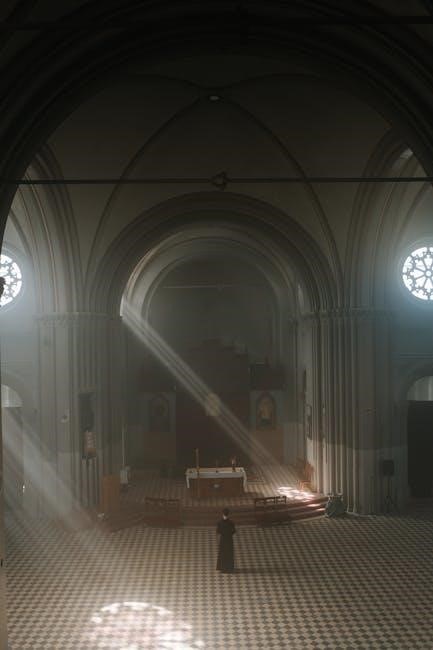
Priest in Different Languages
The term “priest” varies across languages, reflecting cultural nuances. For example, “sacerdote” in Spanish and “prêtre” in French denote the same religious role. Translations reveal diverse linguistic approaches to describing this important figure.
Translations of “Priest”
The word “priest” takes on different forms across languages, reflecting diverse cultural and religious contexts. In Spanish, it’s “sacerdote” or “cura,” while in French, it’s “prêtre.” German uses “Priester,” and Italian employs “sacerdote” or “prete.” These translations often carry subtle nuances, shaped by the specific religious history and linguistic evolution of each language. Understanding these variations offers insight into how different cultures perceive and conceptualize the role of a priest within their societies and religious structures, highlighting the global reach and diverse expressions of this sacred vocation.
Cultural Variations
Cultural perceptions of priests vary significantly worldwide, influencing their roles and responsibilities. In some cultures, priests hold immense authority, acting as spiritual guides and community leaders. Others view them more as ritual specialists or caretakers of sacred traditions. The level of interaction between priests and the laity also differs, ranging from close pastoral relationships to more formal, distant interactions. Furthermore, the attire, lifestyle, and social expectations placed upon priests are shaped by the unique cultural norms and religious practices of each society. These variations underscore the diverse ways in which societies interpret and integrate the concept of priesthood.
Examples of Usage in Sentences
Consider these examples of how “priest” is used in sentences: “The priest offered a comforting sermon during the Sunday service.” Another example: “The villagers sought guidance from the priest on matters of faith and morality.” A further instance: “Before the Reformation, the parish priest was the principal celebrant of the Eucharist.” “The newly ordained priest was eager to serve his community.” Lastly, “The priest’s words brought solace to those grieving.” These illustrate common contexts for using “priest” in everyday language, showcasing their roles within religious settings.
